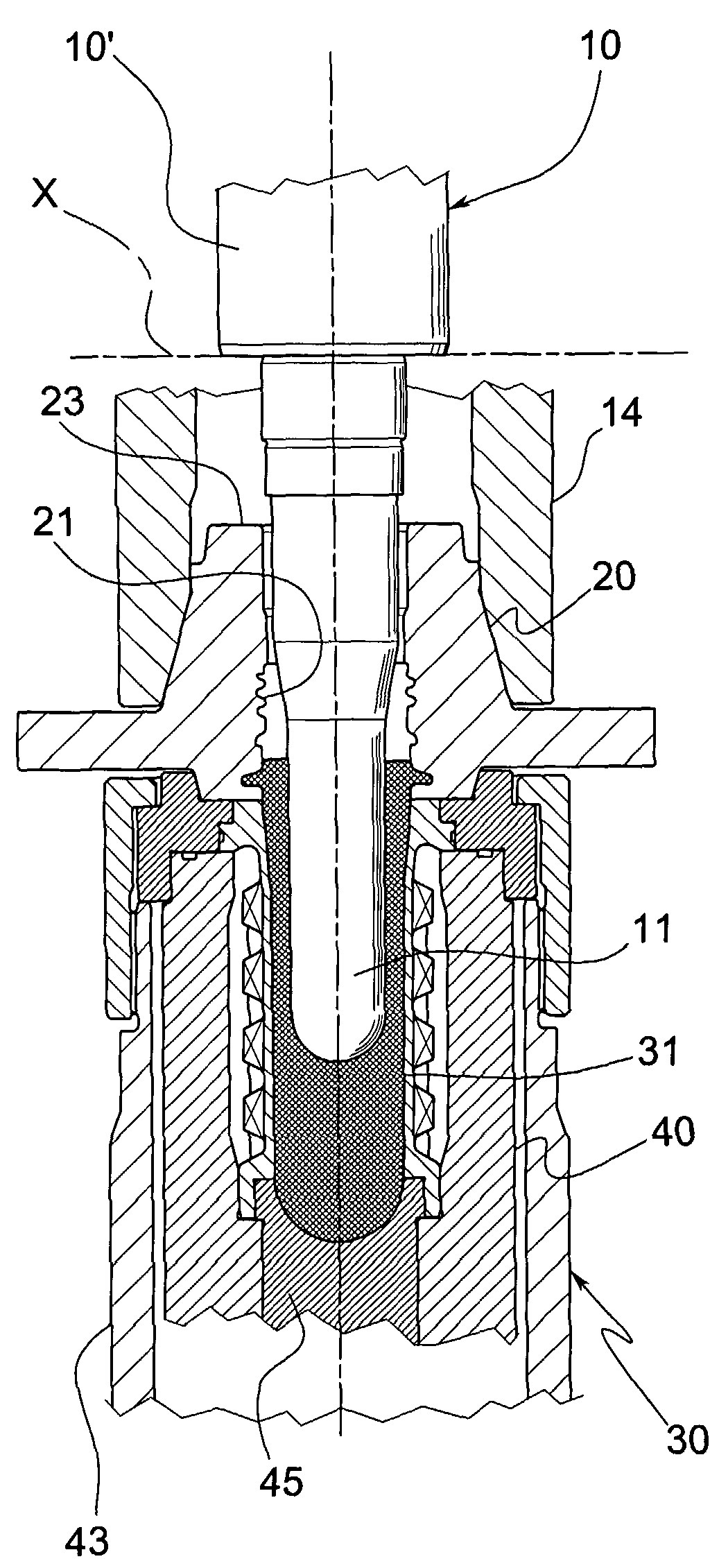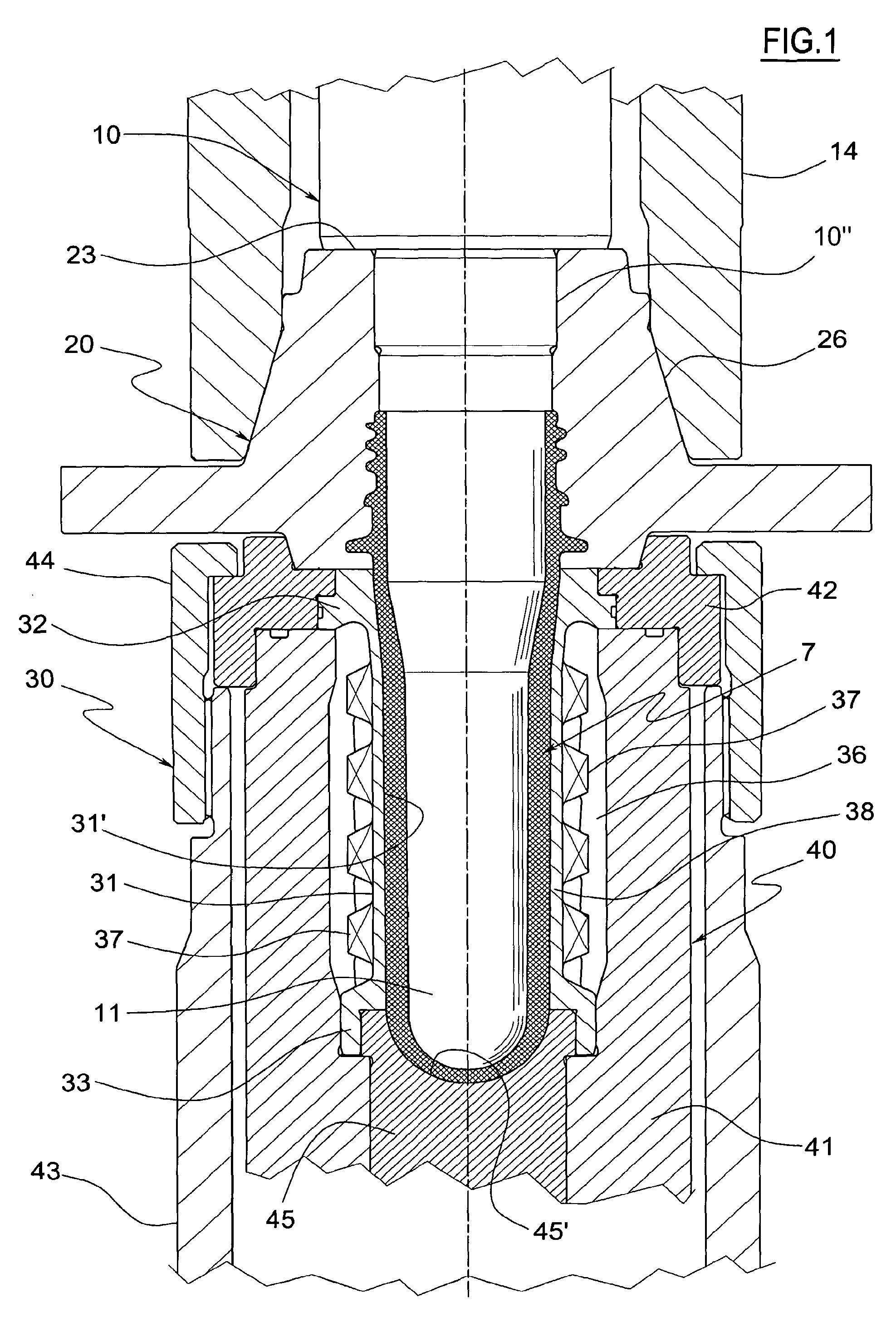Method and group for the compression molding of preforms for containers in polymeric material
a polymeric material and container technology, applied in the field of compression molding of semi-finished preforms, can solve the problems of compensating the inexactness of the mass of the metered body, breaking or to unacceptable damage of the neck parts themselves, and reducing so as to increase the thickness of the hollow body, the effect of less inner tension and less internal tension
- Summary
- Abstract
- Description
- Claims
- Application Information
AI Technical Summary
Benefits of technology
Problems solved by technology
Method used
Image
Examples
first embodiment
[0040] illustrated in FIG. 1, the lower matrix part 30 comprises a portion 38 having tubular form, in particular substantially cylindrical, which defines said deformable wall 31, whose inner surface 31′ confers the shape, at least in part (and in particular, as illustrated, almost completely) of the outer surface of the side wall 92a of the hollow body 92, which wall 31 has a relatively thin thickness which permits it to be elastically deformed under the pressure of the polymeric material.
[0041]The deformable wall 31 is housed, in particular it is enclosed, within a coaxial cavity 36 made in the support body 40, whose inner surface is placed a distance from the outer surface of the wall 31, such that this may be radially deformed without being hindered by the body 40 itself.
[0042]The deformable wall 31 comprises an enlarged section which defines a circular band 32 near the upper end and a second enlarged section, near the lower end, which defines a second circular band 33. Said circ...
second embodiment
[0074]Therefore, also in this second embodiment, as in the first, the deformable wall 31 comprises a deformable tubular portion 38 which has, along the generic axial section, from one side and the other with respect to the axis, two end portions defined by the circular bands 32 and 33, which form abutments which hinder the radial displacement, and a central portion, laminar and having a relatively thin thickness in relation with the axial length, in a single body with the two end portions, free to elastically bend in radial direction, forming an arch in the axial plane. Moreover it also comprises a deformable bottom portion 39 which has, along generic axial section, two end portions, both defined by the circular band 33, and a central portion, having a relatively thin thickness in relation with the length, free to elastically bend in the axial direction.
[0075]The cavity 36 is connected, through a lower mouth 49 made in the central body 45b and other not-illustrated conduits, with me...
third embodiment
[0082]The cavity 36 is connected, through a lower mouth 52 made in the central body 45b and other not-illustrated conduits, with means adapted to circulate refrigerant fluids in the cavity 36 itself capable of removing heat from the preform in a step of thermal conditioning (cooling) of the same. In the lower part of the cavity 36, below the abutment ribs 51, there are several fins 53 projecting upward from the central body 45b, adapted to better direct the flux of the refrigerant fluid, and which do not hinder the deformation of the wall 31 with which they do not come into contact. Also in this third embodiment, the error of the metering is apportioned also to the bottom portion 92b, in addition to the side portion 92a of the hollow body 92.
[0083]There may moreover be foreseen several conduits 54, made in the support body 40, in particular in the central body 45b and in the fins 53, which cross the ribs 51 and the lower band 33, which lead in correspondence with the surfaces of mut...
PUM
| Property | Measurement | Unit |
|---|---|---|
| pressure | aaaaa | aaaaa |
| thickness | aaaaa | aaaaa |
| length | aaaaa | aaaaa |
Abstract
Description
Claims
Application Information
 Login to View More
Login to View More - R&D
- Intellectual Property
- Life Sciences
- Materials
- Tech Scout
- Unparalleled Data Quality
- Higher Quality Content
- 60% Fewer Hallucinations
Browse by: Latest US Patents, China's latest patents, Technical Efficacy Thesaurus, Application Domain, Technology Topic, Popular Technical Reports.
© 2025 PatSnap. All rights reserved.Legal|Privacy policy|Modern Slavery Act Transparency Statement|Sitemap|About US| Contact US: help@patsnap.com



